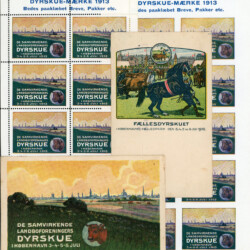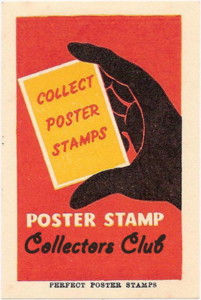The second Chicago World’s Fair opened on May 27, 1933. There were daytime ceremonies held in Soldiers’ Field Stadium, but the real show started after dark. Four observatories in the US aimed their telescopes on the star Arcturus, and at each observatory the light from Arcturus was focused on a light-sensitive photocell, which then sent a signal to Chicago, once all four observatories agreed, the electrical current was used to start a light show at the fair. The concept was that Arcturus is 40 light years away, and 40 years before, in 1893, May 27 was the opening of the first Chicago World’s Fair.
The poster stamp, with unimpressive artwork, was printed for that event, and shows “© by T.W. Wines”.
This very rare surviving booklet (cover above) was distributed at that time and this copy shows some handwriting by Mr. Wines himself. It seemed a bit long to include all of it in the 1933 catalog, so it is getting a showing here.
Page 2 has a copy of the stamp (#30 in the catalog), and written by Mr. Wines is Compliments of artist and designer of “Arcturus Century of Progress” World’s Fair Seals. Chicago 1933 T.W. Wines 1328 East 53rd. Page 3 shows a diagram of the telescopes and electrical connection (assumed along telephone lines) to trigger the fair opening on the evening of May 27.
On pg 5 Wines has written this plan was devised and executed by the late Prof. Edward Brant Frost of the above Observatory. (Yerkes Observatory is underlined). The Yerkes Observatory was started & operated by the University of Chicago and contained the largest (40”) refracting-type telescope in the world, which was displayed at the 1893 Chicago World’s Fair prior to installation (1893 photo is shown). Edwin Brant Frost (1866-1935) was director of the Yerkes Observatory from 1905. He died in May 1935, so Wines’ note, with Edwin misspelled, must have been written long after the fair.

Page 8 and 9 show a crude diagram of the night sky and a guide to finding Arcturus. It is part of the constellation Boötes, and the diagram is wrong in including Polaris. The later pages 11-15 discuss the appearance of Arcturus in ancient religion and mythology.
Page 15 and the back cover show brown toning probably due to the inserts that were included in the back of the booklet.
On the back cover is a publisher’s credit. Arcturus Radio Tube Company was a small electronics manufacturer which officially began in 1926 (registered in Delaware) and ended in bankruptcy in 1937. Apparently the company name was just a coincidence, and it is not clear if T.W. Wines had any connection to Arcturus Co., as it was located in New Jersey. Their tubes were made for use in radios and electronics such as amplifiers; they also made photoelectric cells which could have been parts used in the opening ceremony system.
A card, about 2 7/8″x 5 1/2″ was a loose insert with the booklet. On the back is a rubber handstamp, with T. W. Wines address. Unfortunately, Mr. Wines is long gone, and his former address is now a modern multi-story commercial/residential building. So more research must be done to find any more about Mr. Wines.
Interest in space, science fiction and some naive ideas about future space travel were novel and exciting at this time. The comic strip Buck Rogers was brand new in 1929 and immediately popular. A ten-minute Buck Rogers film, Buck Rogers in the 25th Century: An Interplanetary Battle with the Tiger Men of Mars, premiered at the 1933 Chicago World’s Fair; it was later shown in department stores to promote Buck Rogers merchandise. It was shot in the Action Film Company studio in Chicago, Illinois, and included robots, Martians and other future staples of fantasy in American culture.
Most importantly special thanks to Ed Pieklo for his generous supply of scans and information of this rare Booklet.



























